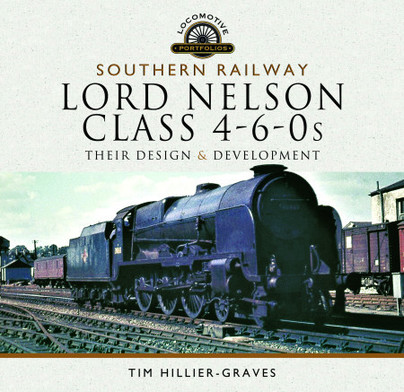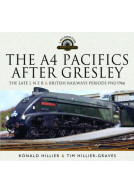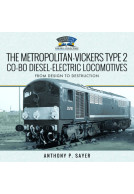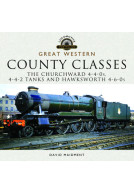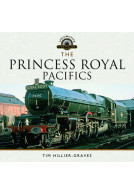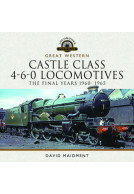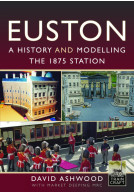Southern Railway, Lord Nelson Class 4-6-0s (Hardback)
Their Design and Development
Imprint: Pen & Sword Transport
Series: Locomotive Portfolios
Pages: 176
Illustrations: 200 colour & black and white
ISBN: 9781526744739
Published: 18th August 2020
(click here for international delivery rates)
Order within the next 6 hours, 33 minutes to get your order processed the next working day!
Need a currency converter? Check XE.com for live rates
The Lord Nelson Class has come to be viewed as an ‘also ran’ amongst express locomotives and is largely overlooked for that reason. It had the misfortune to be sandwiched on Southern metals between the classic and much revered King Arthurs and Schools and by Bullied’s controversial Pacifics. In such company any design might suffer by comparison. And yet when first appearing they attracted plaudits from railway professionals, including the footplate crew, and the public alike. But with only 16 being built their impact was muted and any faults in their design were magnified beyond their actual impact. In truth they deserved far better than this and were, in fact sturdy, reliable performers that served the company well on the heavy boat trains for which they were designed and across their other passenger services for 30 years and more in peace and war.
Much has been written about these locomotives but no story is ever complete, with new information and photographs emerging to deepen our understanding of them. This book provides an in depth view that re-examines these impressive engines using, new material, eye witness accounts, contemporary assessments and more than 200 photographs and drawings.
"This is a well researched and readable book with useful engineering detail."
Model Engineer- October 2022
Your reviewer’s memories of these locomotives stem largely from childhood holidays in the Bournemouth area during the late 1950s and early 1960s. His family generally travelled on the 11-30 express from Waterloo to Bournemouth, which was a regular working for these engines for a period and which was the service that conveniently connected with our early train from Yorkshire. Sir Martin Frobisher comes to mind as being active then. How educational were these locomotive names to small boys! Your reviewer’s final memory of a ‘Nelson’ was during the sunny last afternoon of a summer holiday around 1960. The beach was never a significant competitor to the delights of nearby Poole Park, which was – and still is – bordered on its seaward side by the sharply graded main railway line between Weymouth and Bournemouth. At that time, the up ‘Channel Islands Boat Express’ which ran from Weymouth Quay to London Waterloo and was always composed of ten coaches and a bogie van used to come blasting up the bank behind a Bulleid Pacific, generally banked by a Bournemouth M7 0-4-4 tank. Sometimes, however, any spare engine was sent down to Poole for the banking job – even a Pacific. On this particular afternoon, what should be seen nosing her (his?) way gently down the incline tender-first but Lord Nelson himself? Half an hour later, the boat train duly appeared in the distance leaving Poole station super-powered by the customary hard-working Merchant Navy locomotive at the front and Lord Nelson giving vigorous assistance at the rear. The noise as the green-painted coaches passed the onlookers who were stood alongside Poole Park boating lake was terrific and could still be heard even as the train passed into the far distance. Thus did the ‘Nelsons’ pass into your reviewer’s memory. The following year, they were gone.
Roger Hepworth, Bradford Railway Circles
The book under review could be said to fit the description ‘it does exactly what it says on the tin’. But it actually does quite a bit more than that. The book’s introduction sets the scene for the locomotives’ introduction, following the 1923 grouping. On the newly-formed Southern Railway (SR) there was seen to be a need for a powerful locomotive to rival the Great Western Castles and the LMS Royal Scots. However, because the Southern was investing heavily in electrification, Richard Maunsell, its Chief Mechanical Engineer (CME), was faced with a situation of little money being available for steam locomotive development, this being regarded as something of a sideshow. However, the SR Public relations department were anxious to promote the Lord Nelson class as ‘Britain’s most powerful locomotive’. Following Maunsell’s retirement in 1937, owing to advancing age and ill-health, his successor Oliver Bulleid continued Maunsell’s gradual modification programme – with some success – until the Nelsons were inevitably overshadowed by Bulleid’s Pacifics as well as by the performance of Maunsell’s own highly successful Schools class, which, perhaps ironically, was developed from that designer’s Lord Nelson Class in order to meet the need for a smaller locomotive for express work on secondary routes.
Chapter 1 deals with the evolution of the 4-6-0 type, which had its origins in the USA of the 1840s. However, it was in France, Germany and Great Britain that this type’s adoption was most widespread, with the Highland Railway’s ‘Jones Goods’ class being introduced in 1894. Churchward, Robinson and Webb then took up the cause in earnest. On what was to become SR territory, it was Dugald Drummond who introduced this wheel arrangement during the first decade of the twentieth century. After Drummond’s death in office in 1912, the type was further developed by fellow Scot Robert Urie, who, already in Drummond’s time, had been actively involved in 4-6-0 projects. In August 1918 the first of Urie’s ‘King Arthurs’ appeared – a class which was to reach a total of 74 by its completion in 1926. At the grouping, the post of CME of the newly formed Southern Railway fell to Richard Maunsell. His Irish birth and upbringing are described in some detail. He was a pupil of H A Ivatt, of later Great Northern ‘Atlantic’ fame, at the Inchicore works of the Great Southern and Western Railway of Ireland and, in 1892, was sponsored in his application to join the Institution of Mechanical Engineers by none other than John Aspinall of the Lancashire and Yorkshire Railway. Maunsell had been CME of the South Eastern and Chatham Railway (SECR) since Wainwright’s departure in 1913. He had immediately put together a team of specialists including ‘the talented young engineer and inventor Harold Holcroft’. In 1922 came Maunsell’s N1 4-6-0 class, a development of his N Class of 1917. On the formation of the Southern railway under the 1923 grouping, these classes joined the H15, N15 and S15 classes built by Urie for the London and South Western Railway. At this time, as mentioned earlier in this review, electrification was tending to place steam locomotive development in the shadows. Perhaps surprisingly, Maunsell seems to have got on well with Alfred Rayworth, a man of strong personality and the Southern’s champion of electrification. On the formation of the Southern railway, Maunsell set about moulding a team of able officers to assist him in the overseeing of locomotive and of carriage matters. These men were drawn from the different companies which came together to form the new Southern system and naturally included some who had worked with him earlier on the SECR. The N15s were performing well, but with increasing train weights, something more powerful seemed to be called for. Experiments and developments were made on existing locomotives, with a lot of attention being paid to the optimum number of cylinders and various angles of cranks on the crankshaft. Attention was also paid to the matter of coal consumption and the development of suitable smoke deflectors.
Chapters 2 and 3 describe in detail, with the aid of numerous photographs and engineering drawings, the development of the prototype locomotive and the publicity which surrounded its introduction, the contrasting low-key introduction of the remainder of the class and the ongoing developments made by Maunsell himself up until his retirement, owing to age and poor health, in 1937. We learn of experiments with smaller wheels, different injectors, superheaters and the provision of smoke deflectors. A larger boiler was fitted to Lord Howe, this being to gain experience as part of a possible Maunsell Pacific design.
Chapter 4 describes the arrival of Oliver Bulleid from Nigel Gresley’s London and North Eastern Railway locomotive department at Doncaster. We are told that the new CME was ‘noted for his fertile imagination and dynamism’. Gresley seems to have taught Bulleid ‘the constant need for examination and evaluation’. With his recent experience of the P2 2-8-2 class, Bulleid ‘quickly began a review of all he had inherited’. Under the Southern’s new post-war General Manager, Sir Eustace Missenden, with whom he seems to have developed a good working relationship, Bulleid soon focussed his attention not only on designing and building new locomotives, but also on improving types already in service. He was joined by Clifford Cocks, another LNER man who had been heavily involved with the development of that railway’s highly successful V2 2-6-2 class. Following a simple redesign of the tenders’ coal compartments, to make the firemen’s lives easier, Bulleid then embarked on a detailed study of the locomotives’ exhaust system. Maunsell, we are told had already experimented with a modified Kylchap exhaust, following which Bulleid looked at the Lemaitre system. He also examined the matter of the steam passages in the cylinders, suspecting that right-angled bends in these passages were causing problems. Meanwhile the new wartime regime had come into being at the top of the organisation. The Railway Executive Committee were now in charge, resulting in electrification taking a back-stage position and the emphasis being laid on steam locomotives both to maintain existing services and to handle the increased wartime traffic.
Chapter 5 describes the wartime and post-war history of the locomotives until their eventual demise. Two locomotives in particular needed repairs resulting from damage caused by enemy action but the class as a whole continued to give good service, following Bulleid’s modifications, despite their becoming overshadowed to some extent by the latter designer’s new Pacific types. In particular, the ‘Nelsons’ were still much in demand on the lines to the South Coast and to the West Country. As loads increased on the Bournemouth line, ‘Nelsons’ took over some of the work formerly undertaken by the Schools Class. In the post-war period a number of ‘Nelsons’ were involved in accidents – a firebox crown collapse on Howard of Effingham to the west of Bournemouth, a high-speed derailment involving Sir Francis Drake near Byfleet and a rear-end collision near Farnborough involving a train pulled by Lord Nelson himself. During the 1950s, the engines were tending to fade into relative obscurity, although even at this late stage, modifications were still being made, such as the fitting of Automatic Warning System apparatus, speedometers and modified regulator handles! In early 1961, the inevitable happened and the decision was made to scrap the class. This was accomplished over thirteen months, bringing to a close a roughly thirty year period of sterling service by these 16 locomotives, especially in the hands of footplate crews who were familiar with them. The author sums up that ‘they were good engines, capable of great things on their day with a willing driver and fireman on the footplate’. One of the latter is quoted as saying that they were given the name ‘Whispering Giants’ because of the eight exhaust beats per driving wheel revolution and that ‘they were probably the best 4-6-0 to run on Southern metals, especially after Bulleid had applied his genius to them’.
The extensive Appendix 1 is devoted to an exhaustive ‘curriculum vitae’ of each locomotive, accompanied by multiple photographs of each machine. For each locomotive we are given the Works Order Number, the month of entering traffic, details and dates of modifications, boilers fitted, tenders, liveries, total mileage and date withdrawn. The book is completed by a bibliography and index.
Appendix 2 is devoted to the life history of one locomotive – No 852 Sir Walter Raleigh, again complete with photographs. The author describes her early service on continental boat trains, the various modifications made to her over the years, the massive wartime damage she sustained one night from an enemy bomb on Nine Elms Depot and her subsequent extensive repairs.
The book is completed by a bibliography and index.
To sum up, this a fascinating book, in hard-backed landscape format which treats the Lord Nelson Class in great detail. The author has clearly undertaken extensive research and is able to quote from contemporary sources where appropriate. He has also managed to find a treasure-house of photographs, including some apparently quite rare ones of personalities involved with the design and development of these locomotives. This work deserves a place on the shelf of anyone interested in railways in general and certainly that of someone with a liking for Southern Railway locomotives.
As featured in
Railways Illustrated June 2021
As usual, impeccable documentation that makes any work of the Series "Locomotive Portfolios" have a privileged place in our railway library.
Miniaturas JM
Read the full Spanish review here
The author has researched the class well and included a comprehensive record of each engine, it's a well-written history of the Southern's most powerful 4-6-0 design.
Bulleid Express, Winter 2020-21
...A useful addition to the bookshelves...
The Railway Observer
As a small class of only 16 locos, the Lord Nelsons were sometimes overlooked when compared with their more famous Maunsell and Bulleid stablemates. They must also be seen against a background of the Southern’s heavy concentration of its financial resources on its electrification schemes. This interesting work sets them in context and traces the evolution of the class, the development of the prototype and the story of class members in traffic up to the end of their days.
West Somerset Railway Association
One of the most enlightening parts of the book features the story of the Southern’s internal politics, and how Maunsell set about managing the CME’s department, giving each of his senior managers clearly defined responsibilities and with a relentless emphasis on managing costs. It is clear that two of the most influential names in the development of the Lord Nelsons were in fact James Clayton and Harold Holcroft, who rarely receive the credit which they deserve.
Those with an eye for technical detail will appreciate the author’s inclusion of drawings and plans (including some nice contemporary colour illustrations) and details of the performance of the prototype when under test. We hear that problems soon became apparent with heavy coal consumption, which Maunsell put down to firemen not mastering the special technique needed with a split level grate, and that he felt comparisons between the Nelsons and King Arthurs were not comparing like with like. After Bulleid took over as CME, several modifications to the class were made and these are described in full.
As well as numerous photographs from the Southern and BR eras, the author has included an appendix giving a lot of information on individual class members, with several eye-catching images of the locos at work on their day to day duties.
This is another worthy addition to Pen & Sword’s Locomotive Profile series.
As featured by
Branch Line and Light Railway Publication
About Tim Hillier-Graves
TIM HILLIER-GRAVES was born in North London during 1951. On leaving university he served as an officer with the Royal Navy, seeing wide service on land and sea. For much of this time he specialised in weapon development projects, specifically missiles and heavyweight torpedoes, and worked alongside BAe, Marconi Space and Defence Systems and McDonnell Douglas in the process. In support of this work, he undertook prolonged periods of study and research at the Royal Naval College, Greenwich, and the Royal Military College of Science, Shrivenham. Late in his career he changed specialisms to become Head of Investigations for the MoD’s Estates Organisation. From this he moved on to become Head of Finance and Planning and then into Human Resource Management where he specialised in outsourcing to industry. Then as an Assistant Director he took on responsibility of housing for military personnel. He retired in 2011 to focus more fully on writing biographies and books related to military, aviation and engineering matters.







